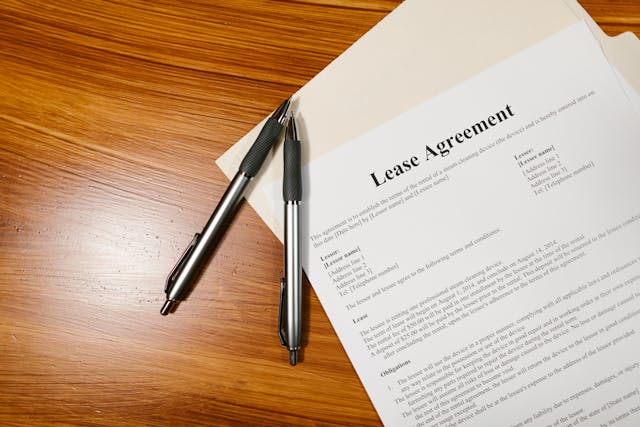
- A rental agreement establishes clear expectations and responsibilities for both landlords and tenants, reducing disputes.
- Essential elements include rent details, lease terms, security deposit conditions, and maintenance responsibilities.
- Liberty Real Estate Services assists landlords in drafting comprehensive rental agreements for a smooth rental experience.
Are you looking for a way to ensure a smooth and hassle-free rental experience with your tenants?
A rental agreement is one of the most important documents you can create as a landlord. A well-drafted rental agreement outlines expectations, responsibilities, and consequences if terms are violated.
It should be thorough and legally sound to avoid issues down the road. At Liberty Real Estate Services, we’ve created a detailed breakdown of what should be included in a rental agreement to help ensure a smooth landlord-tenant relationship.
Learn How We Can Help You Maximize Your Home’s Potential
Essential Elements of a Rental Agreement
1. Names of All Parties Involved
The rental agreement should include the full legal names of all tenants who will be living in the rental unit. This ensures that every adult residing in the property is legally responsible for paying rent and adhering to the lease terms. Additionally, the landlord’s full legal name and contact information should also be included for clarity.
2. Property Description
Provide a clear and detailed description of the rental property. Include the full address, unit number (if applicable), and any specific details that define the space being rented. Mention key features such as square footage, number of bedrooms and bathrooms, and any additional amenities like a backyard, patio, or storage shed. If the property includes shared spaces such as a laundry room or parking lot, those should be listed along with any usage guidelines.
3. Lease Term
Specify whether the agreement is a fixed-term lease or a month-to-month rental. Fixed-term leases usually last for six months, one year, or longer, providing stability for both parties. Month-to-month agreements continue indefinitely until either party provides proper notice, offering more flexibility. Clearly outline the lease start date and, if applicable, the end date.

4. Rent and Payment Details
State the exact monthly rent amount and when it is due each month. Clearly outline the payment methods that are accepted, such as bank transfers, checks, or online platforms. To avoid confusion, specify:
- The penalty for late payments, including the exact late fee and when it applies.
- Any grace period allowed before a late fee is imposed.
- The consequences of repeated late payments or non-payment.
5. Security Deposit
- Clearly outline the amount of the security deposit required and the conditions under which it may be withheld. Specify:
- How and when it will be returned after the tenant moves out.
- Any deductions that may be made for damage, unpaid rent, or cleaning fees beyond normal wear and tear.
- The process for documenting damages and notifying tenants of deductions.
Learn More About Our Company!
6. Maintenance and Repairs
Clarify the responsibilities of both the landlord and the tenant when it comes to maintenance and repairs. The agreement should state:
- Who is responsible for routine maintenance tasks such as changing air filters, mowing the lawn, or clearing gutters.
- How and when tenants should communicate maintenance issues, including emergency situations.
- The process for scheduling repairs and expected response times.
- Whether tenants are allowed to make minor repairs or modifications and under what conditions.
- The consequences for tenants failing to report maintenance issues that result in additional damage.

7. Rules and Restrictions
To avoid conflicts, include clear rules that tenants must follow. Common rules include:
- The limit on how many people can live in the unit.
- Restrictions on subletting, short-term rentals, or guests staying beyond a certain period.
- Smoking policies.
- Pet policies specify whether pets are allowed, any breed or size restrictions, additional pet deposits, and rules for pet behavior.
- Noise regulations, particularly in shared buildings, and quiet hours tenants must adhere to.
8. Utilities and Services
Specify which utilities and services are included in the rent and which the tenant is responsible for paying. These may include:
- Electricity, gas, and water.
- Sewer and trash collection.
- Internet and cable television.
- Lawn care and pest control.
Clarify how payments should be made, whether they are split among multiple tenants, and any additional service fees the tenant may incur.
Discover the Benefits of Partnering With Us
9. Entry Rights
Include a clause stating the landlord’s right to enter the rental unit. In most jurisdictions, landlords must provide advance notice before entering, except in emergencies. Clearly define:
- The required notice period (e.g., 24 or 48 hours).
- The acceptable reasons for entry, such as inspections, repairs, or showing the unit to prospective tenants.
- Any limitations on entry times and days.
- Tenant rights regarding entry refusals and how disputes will be handled.
10. Renewal and Termination Terms
Outline the process for lease renewal and termination. Specify:
- How much notice is required for either party to end the lease.
- Whether lease renewal is automatic or requires tenant confirmation.
- Move-out procedures, including cleaning expectations, return of keys, and final inspection requirements.
- The penalties for breaking the lease early, including any early termination fees.
- The process for subleasing, if permitted, and landlord approval requirements.

11. Violation and Eviction Procedures
Include a section explaining what happens if the tenant violates the lease. Describe the steps the landlord will take, such as written warnings, fines, or eviction proceedings. Ensure that this section complies with local landlord-tenant laws regarding notices, legal eviction processes, and required timeframes for compliance.
12. Legal Disclosures
Depending on your location, you may be required to include specific legal disclosures. These can include:
- Lead-based paint disclosures for properties built before 1978.
- Mold or asbestos warnings.
- Flood zone or natural disaster risk disclosures.
- Local tenant rights and fair housing information.
Ensure compliance with state and local laws by researching required disclosures before drafting the agreement.
13. Signatures of All Parties
Finally, make sure the agreement is signed and dated by both the landlord and all tenants. Without signed agreements, the document might not hold up legally. Provide copies to all parties for their records, ensuring clarity and accountability.
Discover Our Property Management Services!
Bottom Line
A well-written rental agreement protects your property and fosters a smooth landlord-tenant relationship by outlining responsibilities and expectations. Liberty Real Estate Services helps landlords draft legally sound leases that comply with local laws while safeguarding their interests. Contact us today to simplify your property management.
